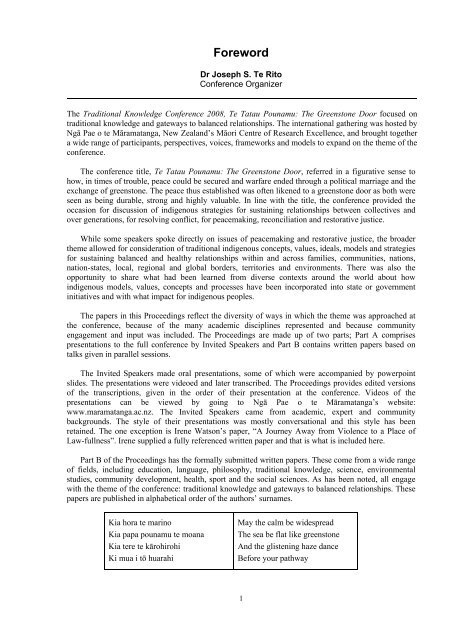traditional knowledge conference 2008 te tatau pounamu
traditional knowledge conference 2008 te tatau pounamu
traditional knowledge conference 2008 te tatau pounamu
You also want an ePaper? Increase the reach of your titles
YUMPU automatically turns print PDFs into web optimized ePapers that Google loves.
ForewordDr Joseph S. Te RitoConference OrganizerThe Traditional Knowledge Conference <strong>2008</strong>, Te Tatau Pounamu: The Greenstone Door focused on<strong>traditional</strong> <strong>knowledge</strong> and ga<strong>te</strong>ways to balanced relationships. The in<strong>te</strong>rnational gathering was hos<strong>te</strong>d byNgā Pae o <strong>te</strong> Māramatanga, New Zealand’s Māori Centre of Research Excellence, and brought togethera wide range of participants, perspectives, voices, frameworks and models to expand on the theme of the<strong>conference</strong>.The <strong>conference</strong> title, Te Tatau Pounamu: The Greenstone Door, referred in a figurative sense tohow, in times of trouble, peace could be secured and warfare ended through a political marriage and theexchange of greenstone. The peace thus established was of<strong>te</strong>n likened to a greenstone door as both wereseen as being durable, strong and highly valuable. In line with the title, the <strong>conference</strong> provided theoccasion for discussion of indigenous stra<strong>te</strong>gies for sustaining relationships between collectives andover generations, for resolving conflict, for peacemaking, reconciliation and restorative justice.While some speakers spoke directly on issues of peacemaking and restorative justice, the broadertheme allowed for consideration of <strong>traditional</strong> indigenous concepts, values, ideals, models and stra<strong>te</strong>giesfor sustaining balanced and healthy relationships within and across families, communities, nations,nation-sta<strong>te</strong>s, local, regional and global borders, <strong>te</strong>rritories and environments. There was also theopportunity to share what had been learned from diverse con<strong>te</strong>xts around the world about howindigenous models, values, concepts and processes have been incorpora<strong>te</strong>d into sta<strong>te</strong> or governmentinitiatives and with what impact for indigenous peoples.The papers in this Proceedings reflect the diversity of ways in which the theme was approached atthe <strong>conference</strong>, because of the many academic disciplines represen<strong>te</strong>d and because communityengagement and input was included. The Proceedings are made up of two parts; Part A comprisespresentations to the full <strong>conference</strong> by Invi<strong>te</strong>d Speakers and Part B contains writ<strong>te</strong>n papers based ontalks given in parallel sessions.The Invi<strong>te</strong>d Speakers made oral presentations, some of which were accompanied by powerpointslides. The presentations were videoed and la<strong>te</strong>r transcribed. The Proceedings provides edi<strong>te</strong>d versionsof the transcriptions, given in the order of their presentation at the <strong>conference</strong>. Videos of thepresentations can be viewed by going to Ngā Pae o <strong>te</strong> Māramatanga’s websi<strong>te</strong>:www.maramatanga.ac.nz. The Invi<strong>te</strong>d Speakers came from academic, expert and communitybackgrounds. The style of their presentations was mostly conversational and this style has beenretained. The one exception is Irene Watson’s paper, “A Journey Away from Violence to a Place ofLaw-fullness”. Irene supplied a fully referenced writ<strong>te</strong>n paper and that is what is included here.Part B of the Proceedings has the formally submit<strong>te</strong>d writ<strong>te</strong>n papers. These come from a wide rangeof fields, including education, language, philosophy, <strong>traditional</strong> <strong>knowledge</strong>, science, environmentalstudies, community development, health, sport and the social sciences. As has been no<strong>te</strong>d, all engagewith the theme of the <strong>conference</strong>: <strong>traditional</strong> <strong>knowledge</strong> and ga<strong>te</strong>ways to balanced relationships. Thesepapers are published in alphabetical order of the authors’ surnames.Kia hora <strong>te</strong> marinoKia papa <strong>pounamu</strong> <strong>te</strong> moanaKia <strong>te</strong>re <strong>te</strong> kārohirohiKi mua i tō huarahiMay the calm be widespreadThe sea be flat like greenstoneAnd the glis<strong>te</strong>ning haze danceBefore your pathway1
















